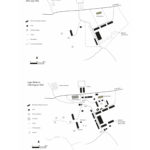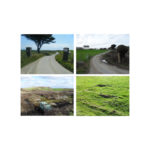Borkum
- Country: Alderney, The Channel Islands
- GPS: 49° 42' 55.6812 N, -2° 11' 19.0212 W,
- Address: Off Longis Road
- Operational: N/A - Active
By Caroline Sturdy Colls and Kevin Colls
When British investigators arrived in Alderney in May 1945, they came across an OT camp which Major Pantcheff described as a ‘normal camp where chaps who were glaziers, carpenters and whatever were accommodated and nothing happened there at all’.1 Borkum was built around Longy House, a pre-existing residence situated on the south side of Longy Road. The camp housed labourers who were recruited for specialist tasks and it was an exception to the rule, in terms of the treatment of labourers on Alderney, as it appears that conditions there were more favourable. This was due to the perceived value for the war effort of the workers residing there. The inmates in Borkum were mostly German workers or volunteers of other nationalities who were selected because they had skills that would benefit the construction industry or operations more generally. Throughout the occupation, obtaining a place in Borkum was desirable as forced labourers realised that being housed there would improve their quality of life and thus increase their chances of survival.
Around 400-500 men were in the camp in July 1942.2 Unlike the other camps on the island, the inmate population fluctuated due to the movement of prisoners, rather than because of illnesses and deaths. In August 1942, Anton Buddy (a tailor) was transferred to Borkum from Norderney labour camp with four fellow Polish tradesmen. He reported that there were 900 German OT workers, twenty Spaniards and thirty Frenchmen housed in the camp at this time.3
Historical and archaeological research has confirmed that no significant fences appear to have been present, likely reflecting the types of workers held there. That said, it was still an OT labour camp and inmates were still expected to conform to certain protocols or face punishment. A report by the British Intelligence Division, M.I.19, describes how the camp was still guarded by OT men even when the inmate population was reduced and that they were ‘armed with long, French type rifles’.4 The fact that significant fortifications and weaponry existed in the vicinity of the camp also reduced the likelihood of escape.
Although the layout of the camp has been determined through the work of Pantcheff, historical scholars, and recent archaeological investigation, very little is known about the conditions in Borkum. The British investigators who arrived in Alderney after the liberation of the island made only passing references to it (likely due to their focus on the other camps where the inmates suffered ill-treatment and violence) and witnesses rarely mention it (as they too were asked about the other camps).5
Once the German prisoners were deported to the UK mainland and the British military departed, the barracks were sold off to islanders after they returned in 1946.6 Consequently, they were moved to various locations across the island for use as homes and functional buildings. Some of the barrack foundations do still survive in situ, along with the camp gateposts, various fortifications and Longy House, which was converted back into a domestic residence. Today, the existence of a working farm and the waste disposal site in the vicinity means that the remains of this camp are still under threat from damage.
References:
1 IWM, MISC 2826 189/2, Nr. 4402, ‘Interview with Bunny Pantcheff’, undated.
2 GARF, Fond 7021, List 149, File 169, ‘Testimonies made by Emil Shulikovsky’, 10 June 1945.
3 TNA, WO211/12, ‘Statement by Anton Buddy’, 28 July 1945.
4 TNA, HO 144/22834, ‘M.I.19 RPS 2141, Report, Channel Islands, Alderney: Further interrogation of informants of M.I.19 (RPS) 2122 and 2136’, 19 April 1944.
5 Sturdy Colls and Colls, 2021 Adolf Island: The Archaeology of the Occupation of Alderney. Manchester University Press. Manchester.
6 Bonnard, B. 2009 Alderney at War 1939-49. Stroud: The History Press, pp.138.
Map
- Cemetery / Mass Grave
- Concentration Camp
- Forced Labour Camp
- Prison
- Worksite / Fortification


